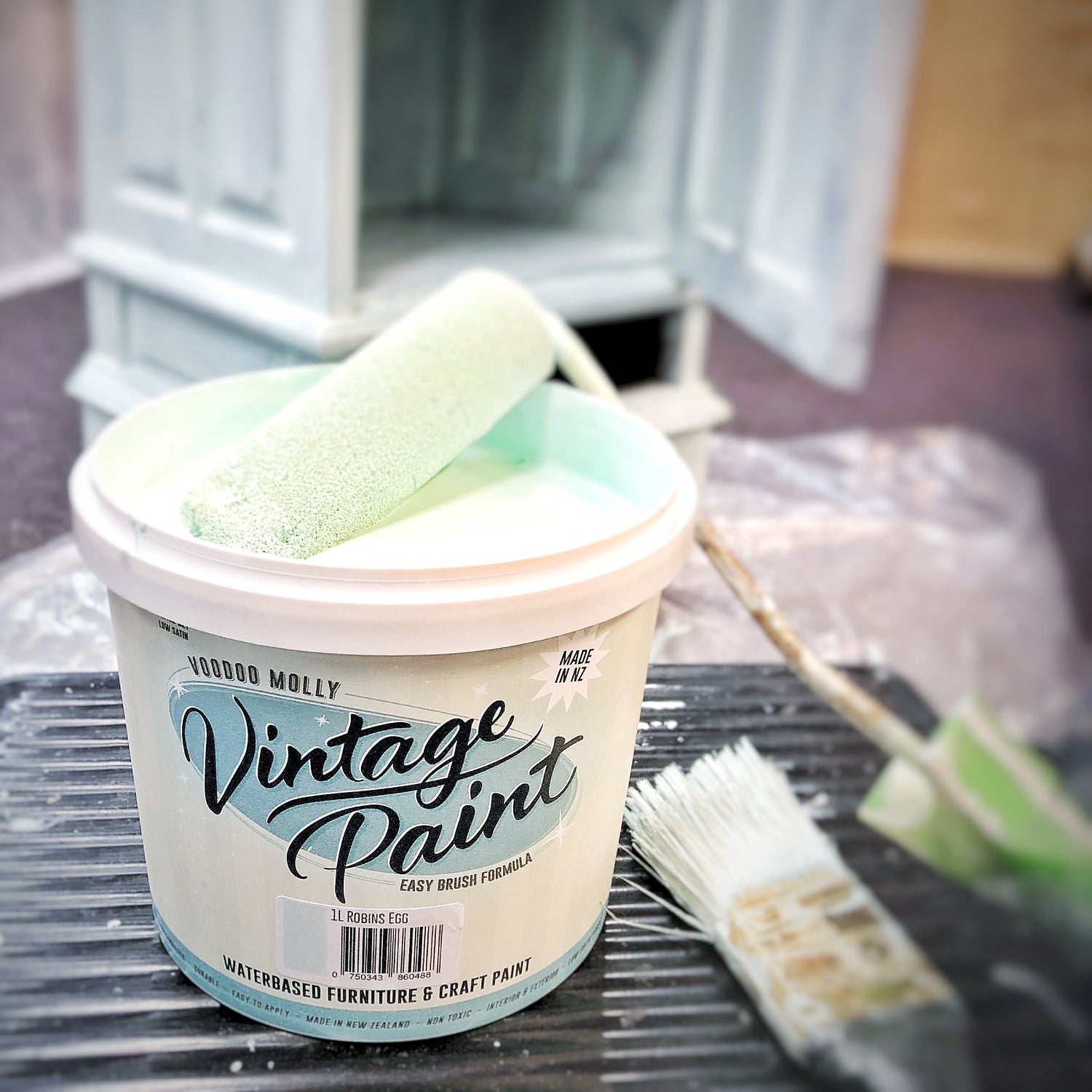Are you eager to dive into the world of upcycling and give second-hand furniture a new lease on life through a fresh coat of Voodoo Molly Vintage Paint? You're in for an exciting journey! However, not all furniture pieces are created equal, and making the right choices at the beginning can save you time, money, and ensure a stunning result. In this blog post, we'll share valuable tips for selecting the perfect pieces to transform into your dream furniture. Whether you're buying for your own home or to sell, we've got you covered.
1. Know Your Style and Dimensions
If you're looking to upcycle furniture for your own use, it's essential to start by defining your style preferences. What designs and aesthetics do you love? Equally important is ensuring that the dimensions of the piece fit seamlessly into your home, both functionally and decoratively. Remember, every piece should complement your lifestyle and intended use to ensure you'll cherish the finished product. Take notes of the approximate measurements of each piece when you go shopping to prevent any unwelcome surprises.
2. Buying for Resale? Go Timeless and Universal
When you're buying furniture with the intention of upcycling and selling your creations, it's essential to focus on selecting timeless and universally appealing pieces. Think of classic designs and styles that have stood the test of time and continue to be in demand.
These pieces tend to have broader market appeal, making them easier to sell. While it's tempting to pick up unique and quirky items, especially as you gain experience and a following, starting with universally appreciated designs can help you build a more stable customer base and generate quicker sales. Remember, once you've established yourself as an upcycling expert, you can start incorporating more unique and unusual pieces into your repertoire, catering to a niche market while maintaining a strong foundation in timeless styles.
3. Check Structural Integrity
Before committing to a piece, it's crucial to ensure that it's structurally sound or, at the very least, requires minimal repairs that you're confident in handling. A sturdy foundation is key to a successful upcycling project.
The last thing you want when upcycling is to discover hidden structural issues that require extensive and expensive repairs. Ensure that the piece you choose is sturdy and free from major structural damage. This includes checking for loose joints, wobbly legs, or weakened frames. If you're confident in your repair skills, minor issues can be manageable, but it's best to avoid anything too complex or costly, especially if you're new to upcycling.
Remember that the furniture you upcycle will be used for its intended purpose, whether it's a chair for seating or a table for dining. If it's not structurally sound, it can pose safety risks. You don't want your beautifully upcycled piece to collapse or become unstable during everyday use.
Repairing structural issues can be time-consuming and might require specialized tools or skills. By choosing furniture that's already in good structural condition, you can focus your efforts on the creative aspects of upcycling, such as painting, refinishing, or adding decorative elements, rather than sinking significant time into extensive repairs.
4. Watch Out for Borer
When you're considering a piece of furniture for upcycling, it's essential to inspect it for signs of borer infestation or borer holes. Here's why this step is important:
Borer, which are wood-boring insects, can cause significant damage to wooden furniture. They tunnel through the wood, creating holes and weakening the structural integrity of the piece. If you upcycle furniture that's infested with borer, you risk ending up with a structurally unsound item that might not hold up over time.
If you bring furniture infested with borer into your workspace or home, you risk the infestation spreading to other wooden items. Borers can be challenging to eradicate once they infest a space, so it's crucial to avoid introducing them in the first place.
Here are steps to follow when checking for borers:
Visual Inspection: Look closely at the furniture's surface and crevices for small holes or tunnels. These are signs of borer activity. Also, check for sawdust-like dust, which is a byproduct of borer activity.
Knock and Listen: Gently tap the wood with a hard object. If you hear a hollow or papery sound, it could indicate the presence of borers.
Check for Exit Holes: Borers create exit holes when they emerge from the wood. These holes are usually small and round. If you see these, it's a clear sign of infestation.
If you find any of these signs, it might be best to avoid the piece altogether, as treating borer infestations can be complex and may require specialized pest control measures. It's a wise precaution to protect your other furniture and your workspace from potential infestations.
5. Opt for Solid Wood
Selecting the right type of wood for your upcycling project is essential to achieve the best results. Here's why choosing solid wood and avoiding laminated styles is crucial:
Solid wood furniture is highly desirable for upcycling because of its durability and longevity. It can withstand the wear and tear of everyday use and the refinishing process. Solid wood pieces are often sturdier, making them more reliable candidates for upcycling. They can be sanded, painted, and refinished multiple times without compromising their structural integrity.
While solid wood is preferable, some composite wood pieces come with a thin layer of real wood veneer. Veneer is a thin sheet of actual wood that's glued onto the surface. This can be a suitable alternative, as veneer can be painted similarly to solid wood, and it offers a more natural wood appearance. However, take care not to sand through the veneer, as this can affect the finish.
In contrast, laminated styles, which include furniture made from composites like chipboard, MDF, or plywood with a laminated finish, present challenges. Laminated wood has a plastic-like surface that doesn't readily accept paint. Painting directly on laminate can result in poor adhesion, uneven finish, and a less professional look. Therefore, it's generally best to avoid laminated styles when upcycling, especially if you're new to the process.
If you do come across laminate furniture that you absolutely must upcycle, there is a solution. You can use Voodoo Molly Boncoat Primer, which is specially designed to create a suitable surface for paint on laminated wood. This primer helps paint adhere better to the laminate, ensuring a smoother finish.
6. Beware of Unpainted Redwood
When considering furniture for upcycling, it's important to be aware of the potential issues associated with unpainted redwood, such as mahogany, and the occurrence of tannin stains. Here's why this step is significant:
Redwood, like mahogany, often contains natural tannins. These tannins can leach out of the wood and bleed through paint, causing unsightly stains on the painted surface. If you don't take the necessary precautions, your upcycled furniture may develop discolored areas, even after multiple coats of paint. Tannin stains are especially likely to occur when you're using lighter paint colors.
To avoid tannin stains, it's a good practice to use a Stainblock Primer before painting. This specialized primer is designed to seal in the tannins and prevent them from affecting the paint's appearance. While it adds an extra step to the process, it's an essential one when dealing with tannin-rich woods. Using a Stainblock Primer helps ensure that your painted finish remains clean and uniform.
If you want to avoid the added effort and cost of using a Stainblock Primer, it's best to steer clear of unpainted redwood furniture altogether or opt for pre-painted pieces. Pre-painted furniture, or pieces with a finish that's already been sealed, reduces the risk of tannin stains and simplifies your upcycling process.
By following these tips, you'll be well-equipped to find the perfect furniture pieces for your upcycling and painting projects. So, roll up your sleeves, pick up your paintbrush, and let your creative journey begin! Happy upcycling!


